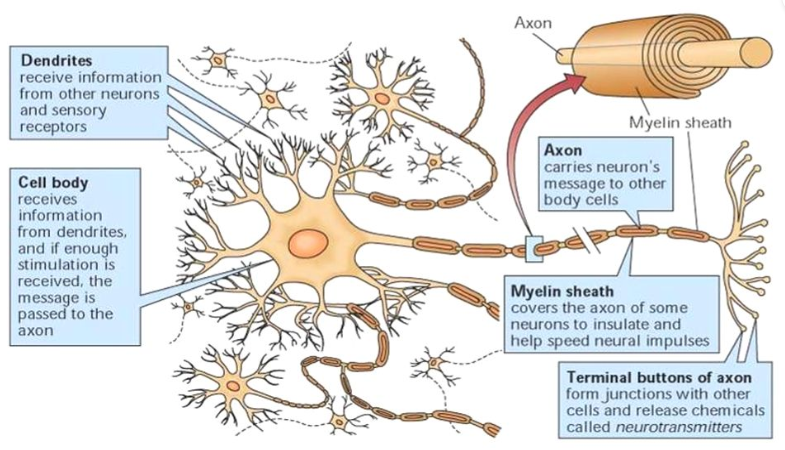Chapter 2 - The Role of Biology in Psychology
Structure of a Neuron

Synapse Cloud - Communication takes place through neurotransmitters (area between terminal button and dendrites?
Neurotransmitters are the chemical signals sent between neurons. They have a similar structure to an enzyme. They meet the receptors of the next neuron and bind to them for a split second. And then they are either destroyed in the synapse or are taken back up by the presynaptic neuron in a process known as reuptake. Neurotransmitters are important because without them our body can not carry out our basic functions.
The two parts of the Nervous System
Peripheral Nervous System (PNS) - The part of your nervous system that contains %%all the nerves and neurons%% except the ones in your brain and spinal cord.
- Somatic - transmits sensory and motor signals between the CNS and skin, muscles, and joints
- Autonomic - transmits sensory and motor signals between the CNS and @@body’s glands and internal organs@@
Central Nervous System (CNS) - the part that only consists of the %%brain and spinal cord%%.
- Drugs can either increase or decrease the effect of neurotransmitters.
Drugs 👀
- Agonists - enhance the actions of a neurotransmitter. For example, nicotine is a drug that has a chemical structure similar to a neurotransmitter. Because of that, the receptors can’t tell the difference so they bind to the nicotine as well. This causes the short-term side effects of smoking.
- Antagonist - inhibit (decrease) the actions of a neurotransmitter. For example, drugs can be administered to patients with opioid addiction. When they administer the drug they bind with the receptors and prevent the opioid from binding with the same receptors.
Techniques for modern Brain Research -
- Electroencephalograph (EEG) - records electrical impulses in different areas of the brain
- Functional Magnetic Resonance Imaging (fMRI) - measures changes in blood oxygen levels
- Transcranial Magnetic Stimulation (TMS) - super strong magnet momentarily disrupts activity in a certain part of the brain
The 3 Main Brain Divisions 🧠
- Hindbrain - responsible for %%survival%% functions as well as %%coordination%% and balance-related movement
- Medulla: breathing, heart rate, and other survival mechanisms
- Pons: sleep, arousal, left-right body movement coordination
- Cerebellum: motor learning, coordination, balance
- Midbrain - responsible for @@voluntary movement@@ (muscle movement)
- Substantia Nigra: initiates voluntary motor movement
- Forebrain - responsible for motivations, emotions, and complex thoughts
Usually, professors don’t ask about the subparts of the Hindbrain or Midbrain, they focus more on the Forebrain
Functions of the Forebrain’s ^^subcortical^^ structures -
Subcortical = deep inside the brain
- Hypothalamus - regulation of body functions (sleep, temperature) and motivates behavior (hunger, thirst, sex)
- Thalamus - sensory info (except smell)
- Hippocampus - formation of new memories
- Amygdala - association of emotions with experiences
Functions of the Forebrain’s %%cortical%% structures -
cortical = your brain’s outermost layer
- Occipital Lobes - vision
- Parietal Lobes - touch and spatial (structural) information
- Temporal Lobes - hearing, memory
- Frontal Lobes - planning, movement, and complex thought
- Prefrontal Cortex - a wide variety of ^^decision-making functions^^, including focusing on something, predicting the consequence of an action, anticipating events, impulse control, and managing emotion
The two parts of the Autonomic Nervous System
(parts control the endocrine system as well)
- Sympathetic - prepares the body for action
- Parasympathetic - returns the body back to the resting state
- Plasticity - property of the brain that causes change due to experience, injury, and drugs.
Nature vs Nurture Debate -
| Nature - our @@genetics@@ determine our behavior. Our personality traits and abilities are in our nature. | Nurture - Our @@environment, upbringing, and life experiences@@ determine our behavior. We are “nurtured” to behave in certain ways. |
|---|
For example - you inherited a predisposition (inclination) to alcohol but you were raised around careful drinkers as a result the predisposition may not be expressed.
\n